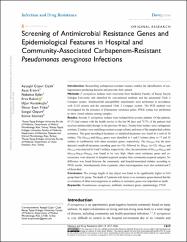Screening of antimicrobial resistance genes and epidemiological features in hospital and community-associated Carbapenem-Desistant Pseudomonas Aeruginosa infections

View/
Access
info:eu-repo/semantics/openAccessDate
2021Author
Çiçek, Ayşegül ÇopurErtürk, Ayşe
Ejder, Nebahat
Rakıcı, Erva
Kostakoğlu, Uğur
Yıldız, İlknur Esen
Özyurt, Songül
Sönmez, Emine
Metadata
Show full item recordCitation
Çopur Çiçek, A., Ertürk, A., Ejder, N., Rakici, E., Kostakoğlu, U., Esen Yıldız, İ., Özyurt, S., & Sönmez, E. (2021). Screening of Antimicrobial Resistance Genes and Epidemiological Features in Hospital and Community-Associated Carbapenem-Resistant Pseudomonas aeruginosa Infections. Infection and drug resistance, 14, 1517–1526. https://doi.org/10.2147/IDR.S299742Abstract
Introduction: Researching carbapenem-resistant isolates enables the identification of carbapenemase-producing bacteria and prevents their spread.
Methods: P. aeruginosa isolates were recovered from Medicine Faculty of Recep Tayyip Erdogan University and identified by conventional methods and the automated Vitek 2 Compact system. Antimicrobial susceptibility experiments were performed in accordance with CLSI criteria and the automated Vitek 2 Compact system. The PCR method was investigated for the presence of beta-lactamase resistance genes. PFGE typing was performed to show clonal relation among samples.
Results: Seventy P. aeruginosa isolates were isolated from seventy patients. Of the patients, 67.1% had contact with the health service in the last 90 days and 75.7% of the patients had received antimicrobial therapy in the previous 90 days. Twenty-four isolates were carbapenem resistant, 2 isolates were multidrug-resistant except colistin, and none of the samples had colistin resistance. The gene encoding beta-lactamase or metallo-beta-lactamase was found in a total of 36 isolates. The bla(VEB) and bla(PER) genes were identified in 1 and 5 isolates alone or 17 and 13 isolates in combination with other resistance genes, respectively. The bla(NDM) was the most detected metallo-ss-lactamase encoding gene (n=18), followed by bla(KPC) (n=12). bla(IMP) and bla(VIM) were detected in 5 and 1 isolates, respectively. Also, the association of bla(VEB)-bla(PER) and bla(VEB)-bla(KPC)-bla(NDM) was found to be very high. Much more resistance genes and co-occurrence were detected in hospital-acquired samples than community-acquired samples. No difference was found between the community and hospital-associated isolates according to PFGE results. Simultaneously from 6 patients, other microorganisms were also isolated and 5 of them died.
Conclusion: The average length of stay (days) was found to be significantly higher in HAI group than CAI group. The death of 5 patients with fewer or no resistance genes showed that the co-existence of other microorganisms in addition to resistance genes was important on death.

















